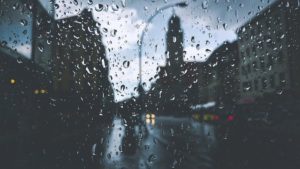Rediscovering Japan’s Technology
CONTENTS
Experience Japan's Technology
By Ryoji Shimada, staff writer

JR Osaka Station is the largest rail terminal in this prefecture of 9 million people. Following years of redevelopment, the multi-use Umekita Grand Front Osaka complex, on the station’s north side has been buzzing since its opening, which took place on April 26. In its first month alone, the 266 shops and other businesses therein have attracted 7.61 million visitors who spent more than 5 billion yen. They are aiming at 25 million visitors by the end of March next year, but they have almost reached one-third of that goal.
The new complex encompasses many interesting tenants that make it more than just a commercial zone. One of these is the “Knowledge Capital” that introduces aspects of sophisticated creativity. The space is occupied by corporations and university research organizations, and by making these accessible to the general public aim at better and practical results from their research.

According to the operator, Knowledge Capital Inc., no similar facility currently exists in Japan, and few can be found in other parts of the world. Its director Mr. Miyahara told us, “What we’re looking for is to achieve a fusion of scientific technology and sensitivity. We want to put everyone in touch with interesting things, and by so doing invigorate the city of Osaka.”
One of the outstanding exhibits in Knowledge Capital is “The Lab -- The World’s Number 1 Laboratory for Everyone,” which extends from the building’s first basement to the third floor. Visitors can see, touch, experience and talk about a number of prototypes under development by companies and universities, including advanced care-giving service robots for example. Let’s take a look at some parts of The Lab. First, at the Café Labo on the first floor, visitors can obtain information about the exhibits in Knowledge Capital. In addition to functioning as an ordinary café, visitors can use terminals at each table to browse through the latest digital magazines and comics available only on-site. Hands-on workshops are also scheduled periodically at which visitors can experience while learning through doing.

The first basement is the event labo. In addition to various events aimed at communicating the concept of Knowledge Capital, there are exhibitions, events, and programs on this floor that introduce leading-edge technology and outstanding works of art. At present, The “World’s Best” exhibit, commemorating the opening, will run until September 1 (Http://the-sekai1.jp/about/). The exhibit features examples of world-leading technology from Japan from the past to the present. While Japan’s GDP fell from 2nd to 3rd place, suggesting its presence is waning, anyone who sees this exhibition is likely to conclude, “Japan was fantastic!” “And it’s still fantastic!” The exhibit begins with a corner that introduces some of the products that helped bring prosperity to Japan and even abroad, which are displayed under the theme “Innovations that changed Japan and changed the world.”
Japanese products and technologies are the best in the world

In 1958, Honda Motor Co. launched its “Super Cub,” which was created under the concept of “A motorbike that anyone can ride as easily as a bicycle.” This model, which is still being produced, has sold a total of 76 million units, a Guinness record.
Japan’s economy underwent rapid development from 1954 to 1973. Around this time, it became common for homes to obtain what was humorously called the “three sacred treasures” of modern times, which were black and white TVs, washing machines and refrigerators. The electric rice steamer was also popularized. It drove sooty, charcoal-heated pots from the home and was instrumental in reducing women’s household chores and enabling active participation of women in society.

In 1979, Sony astounded the world with its “Walkman,” a personal stereo cassette player, created with the concept of “letting people enjoy music anywhere, without bothering others.” Young people throughout the world supported this new style of enjoying music. It can be said that it is the prototype of the Apple iPod.

Now, calculator functions are built into mobile phones and prices for calculators have dropped to the point that they can be purchased at “dollar shops.” But at the time they first appeared on the market, they were luxury items. The world’s first desktop electric calculator with LCD readout, made by Sharp, sold for 26,800 yen ($268) back then. It expedited the change from abacus to calculator.
In addition, you can find such products as ever sharp pencils, cup noodles and other examples of Japanese culture and technology which succeeded not only in Japan, but around the world. While some have said that Japanese were good at copying things, the many original and creative products here suggest otherwise. However, this does not apply only to the past. Move on to the next corner, and you’ll see how the spirit of innovation is thriving right now as well. “Eureka! World’s Best Life” can be found all around us, and at this corner you can see examples of how Japan is supporting avant-garde technology, through such products on display as strong and lightweight carbon fiber, which is used in the bodies and wings of wide-body aircraft; fibers that heat up using the wearer’s body sweat; sushi-making robots; automatic squid catching machines; through such soft power as Hatsune Miku and Hello Kitty.

Midorimushi cake 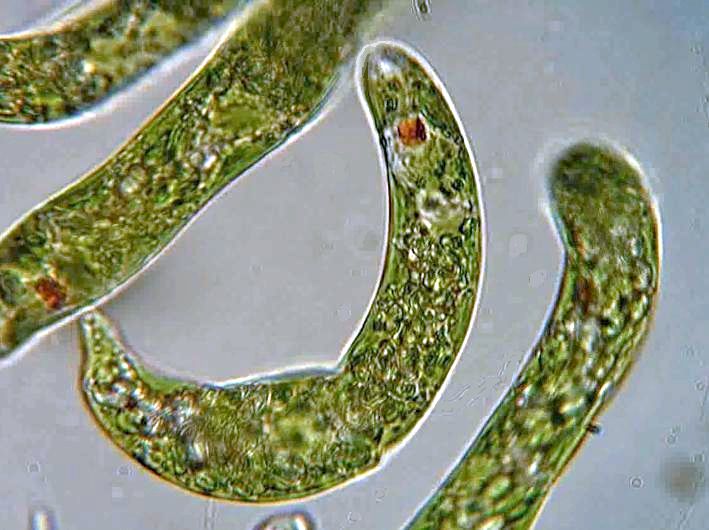
Midorimushi seen through a microscope
Midorimushi (Euglena) is a genus of unicellular flagellate protists. Having characteristics of both plants and animals, each microorganism is typically just 0.05mm in length. Euglena Co., Ltd. was the world’s first to succeed in cultivating it out of doors in a big amount for human consumption, putting on sale Midorimushi cookies, which boast 59 nutrients, including vitamins, minerals, amino acids, DHA, EPA and others. At present the company is engaged in research into solid carbohydrates, water purification and biofuels.

Flavored kamaboko (steamed fish paste), first developed in the 1970s, has become a healthy food that’s now enjoyed around the world in such countries as the USA, Russia, France, Morocco, Brazil and others. The market was created after Yanagiya Machinery Co., Ltd. developed a kanikama making machine. Ingredients can be blended to match the preferences of various countries’ food cultures, enabling diversified products. At present the company dominates the world market with a 70% share.
“Kaiten-zushi,” restaurants serving sushi via moving conveyor belts, have become popular around the world. Ishino Seisakusho Co., Ltd. has supported growth of this market with its conveyor products, for which it holds a 60% share. Its latest product features a chainless conveyor in which the dishes move magically without movement by the belt itself, thanks to use of magnetic power. The new design has gained praise for its quiet operation and ease of cleaning.

This fiber is made by application of dye technology and then passing it through an electric current. Even when the thread is stretched or loosened, it does not lose its ability to conduct electrical current. It may someday be used to replace copper and other metal wires. Currently they are trying to reduce electrical resistance.

Hello Kitty, Transformers and other world-famous characters and toys 
A life-size figure of singing humanoid Hatsune Miku.
Japan's Soft Power
Not only does Japan excel at advanced technology; it also influences the world in fields involving soft power. Hello Kitty products, in some 50,000 varieties are sold each year in 109 countries. The humanoid Hatsune Miku, as “software that sings songs,” went on sale from 2007 as a character that appears on software packaging. Many amateur creators utilize Hatsune Miku speech synthesis software to produce music, which they release on the Internet. Many creators of illustrations and moving images also obtain rights from Cyrpton Future Media, Inc. to generate productions using Hatsune Miku, which are posted online. Hatsune Miku has become popular as a virtual singer not only in Japan but overseas as well. She has given “concerts” both at home and abroad using 3D imaging technology. In the next display corner, called “Sneak Peek! The World’s Best Factory,” which gives a look into the essence of the high technologies and quality that has supported Japanese manufacturing. There are electronics compasses used in smart phones that are smaller than a sesame seed; anti-reflective films that prevent screen reflection and resist scratches or dirt; and a variety of medical related items, from a prototype spray that highlights the presence of cancer cells to a hypodermic needle that measures only 0.18mm at its point, enabling painless injections.

Smart phone performance gets more and more sophisticated. One of the things that makes it possible is miniaturization of components with larger capacity. Murata Manufacturing Co., Ltd. produces the world’s smallest monolithic ceramic capacitors, measuring 0.25X0.125mm --- a size nearly invisible to the naked eye. Smart phone circuits contain some 500 to 700 of these.
Japan’s technology also shines in the separators that are used to prevent aluminum foil of capacitors from making contacts with other parts. Nippon Kodoshi Corporation, which holds a 60% world share, produces high-quality paper with fixed density and thickness that was developed from washi traditional paper-making technology.
Japan also boasts some of the world’s most advanced processing technology. It holds an 80% share of the equipment used for cutting silicon wafers into chips for semiconductors. Using the technology developed by DISCO Corporation, a single human hair can be cross-cut into 35 segments, and the lead in an ever sharp pencil about 850 segments. Through such precision cutting technology semiconductor chips can be reduced in size, contributing to the slimmer dimensions of such products as smart phones and televisions.

Japan is among the world’s top manufacturers of bearings, which are an essential component in machinery of all types. Here, Minebea Co, Ltd., which holds a 60% share of the world market for miniature ball bearings of 22mm and smaller diameter, producing 200 millions of them per month, displays an ultra-small ball bearing with an outer diameter of just 1.5mm. It proposes use in medical equipment or the drive sections of micro machinery.
In addition, there are innumerable examples of Japan’s excellent technology on display, such as this world map (measuring 1.3mm x 2.1mm) that was produced with the world’s smallest drops, which are one-one thousandth the size of those for a home-use ink jet printer. If you are Japanese, you feel proud of those home-grown technologies. If you are non-Japanese, you must be astounded by them.

Actually at the entrance to the exhibit is a diagram showing the percentage of world’s market share held by Japanese manufacturing fields. For example, as opposed to only 27% market share worldwide, Japanese automobile industry’s total value stands at a whopping 39.3 trillion yen ($393 billion) and Japan holds 11% of medical and pharmaceutical products worldwide with a total value of 9.7 trillion yen ($97 billion). However, in high-tensile strength steel, valued at 3.4 trillion yen ($34 billion), Japan holds a 79% world share. It has 100% of the market share for digital SLR cameras (with a value of 571.5 billion yen, $5.7 billion), and 97% of endoscopes for medical use, valued at 163 billion yen ($1.6 billion). Those examples are found in various minute industries where Japan still holds world top-class market shares.
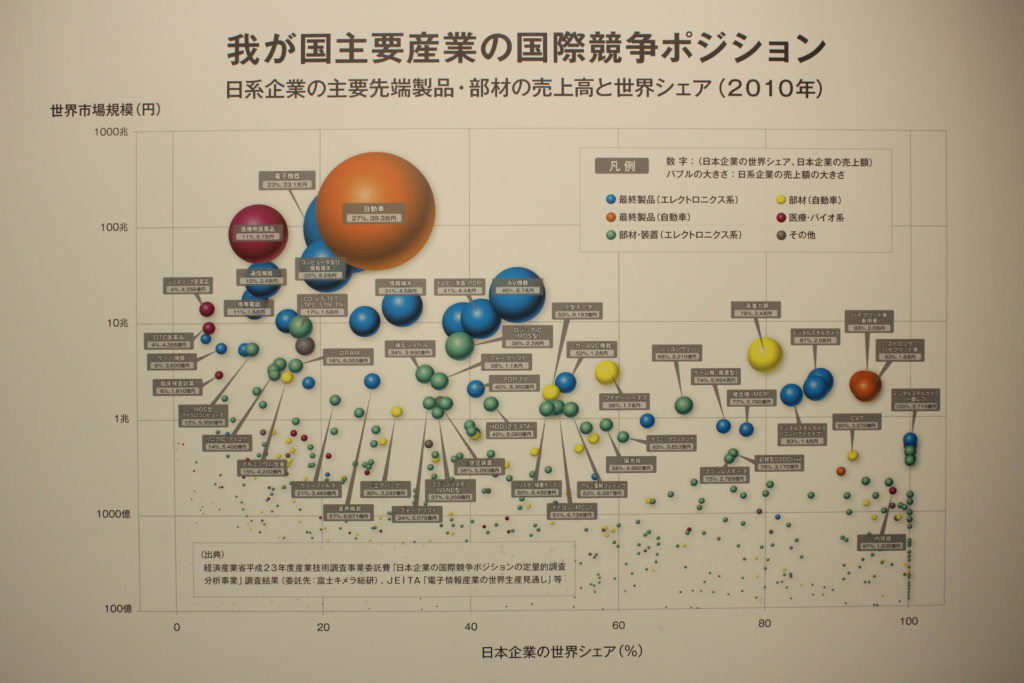
This exhibit will continue until September 1, after which it is scheduled to move to the National Museum of Emerging Science and Innovation in Tokyo.
An attempt to establish contact with consumers
The second and third floors of The Lab. feature a space called Active Labo. They introduce prototypes of products and services developed by businesses and universities through R&D efforts in various areas, such as eyeglass-type computers, 3D digital fashion technology, advanced health-care service robots and others. The aim of publicizing these advanced technologies is to obtain viewpoints of the actual end-users and link these to practical development of the products. Currently 15 companies, universities and research organizations are taking part. Let’s take a look at some of their main exhibits.
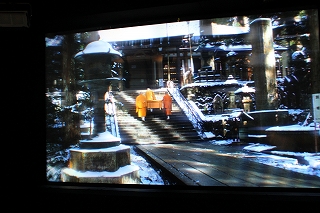
As seen from the left 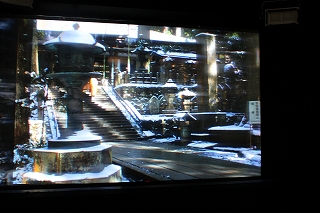
As seen from the right
First is a 200-inch naked eye three-dimensional display on exhibit by the National Institute of Information and Communications Technology, an organization with independent legal status. While displays of 3D images visible by the naked eye gained attention several years ago, this is the world’s first of its kind in such a large, 200-inch display. What makes this one different from other 3D displays is that what viewers see will vary according to from where they view it. Looking at the display from the left side, the stone lantern in the foreground blocks part of the steps behind it, but by moving to the right the steps can be clearly viewed in their entirety. It almost gives the sense that viewers are actually on the scene. By harnessing this high sense of presence, this technology is expected to find use for electronic advertisements, in showrooms or other types of public viewing venues.

At the booth operated by Digital Fashion Co., Ltd. exhibits conventional fashion incorporated into digital technology that is producing garments using 3D. The display shows 3D garment making based on body data collected from obtaining human body measurements with a 3D scanner. It introduces the process of production of a garment based on matching one’s preferences to one’s body type.
The booth operated by Toppan Printing Co., Ltd. exhibits a 3D model based on a famous painting, “The Milkmaid,” by 17th century Dutch master Johannes Vermeer. This makes it possible to view the image from different angles. With high-definition photographic data, three-dimensional form measurement data and color data, a cultural treasure can be faithfully reproduced, making it possible for works that cannot travel far from their museum display to be viewed and experienced by people in other places.

A 3D miniature of the painting created by 3D printer 
A model produced using a 3D printer enables a person to view areas not shown in the original picture of Johannes Vermeer’s The Milkmaid.
Green Lord Motors’ booth features an electric version of the legendary Tommykaira ZZ sports car. The gasoline version of this car was produced in the UK from 1997 and exported to Japan. After delivery of 296 units, however, Japan’s Ministry of Transport changed the safety standards, which required major changes in the body structure, resulting in sales of another 400 units to be halted. But this year the Tommykaira ZZ was reincarnated as an electric vehicle. Use of an electric motor enabled significant weight reduction, which succeeded in boosting acceleration. Its body, weighing just 850kg, is powered by a 305-horsepower motor, enabling it to accelerate from zero to 100 kilometers per hour in just 3.9 seconds. Sales were limited to 99 units, at a price of 8 million yen each. By mid-June, more than half the output had been reserved.

In the booth operated by Nippon Telegraph and Telephone Corporation, there is an exhibit showing a TV of the future, “you can see what you want.” For example, this device enables viewers to see where they want. A soccer live broadcasting usually shows only where a ball is, but with this device, not only they can zoom in or zoom out, but also focus on other locations of the stadium. The zoom function also works for a concert, enabling the screen to focus on a single performer out of other band members for example. Another feature of the booth is a button that lets visitors convey their opinions, providing a choice of either “This is really good” or “It needs more improvement.” This kind of interactivity is one of the most appealing features of the Active Labo.

In the booth operated by Konoike Transport, a robot arm, developed jointly with Muscle Corporation exhibits the theme of “Seeking to substitute or reduce personnel through robots that perform labor using human effort.” The force being applied at the end of the arm can be felt by the operator’s controls, a sensation that has not existed up to now. Visitors can experience operation themselves and the feedback they provide can be utilized in future development efforts.
Actually specialist staff --- called “communications” --- are on hand to observe visitor reactions and comments, which they feed back to the developers. Even when vistors’ remarks are not relayed to the developers directly, the communicators will serve this purpose. And because they are trained to listen, they are skilled at encouraging visitors to express their true feelings.

Knowledge Capital features many other places to see other than The Lab. In the Future Life showroom, companies, universities and others in a variety of fields propose steps toward the future, making this a contact point for communication with ordinary citizens. The 21 tenants not only offer stores with things for sale and showrooms where things can be seen, but where visitors can discover, and learn about these proposals through stimulating experiences. In any event, the common concept running through all of Knowledge Capital is “interactivity.” Unlike a conventional shopping mall, it transcends the simple pattern of buyer and seller, standing out as a new type of facility for human communication to be found.

